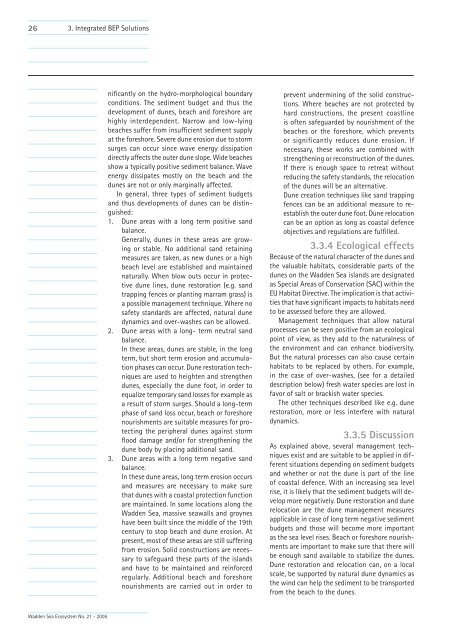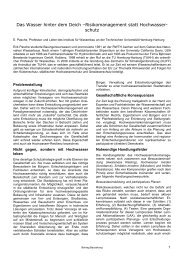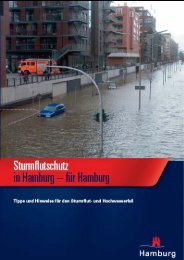Coastal Protection and Sea Level Rise - Hochwasser
Coastal Protection and Sea Level Rise - Hochwasser
Coastal Protection and Sea Level Rise - Hochwasser
Create successful ePaper yourself
Turn your PDF publications into a flip-book with our unique Google optimized e-Paper software.
26<br />
3. Integrated BEP Solutions<br />
nificantly on the hydro-morphological boundary<br />
conditions. The sediment budget <strong>and</strong> thus the<br />
development of dunes, beach <strong>and</strong> foreshore are<br />
highly interdependent. Narrow <strong>and</strong> low-lying<br />
beaches suffer from insufficient sediment supply<br />
at the foreshore. Severe dune erosion due to storm<br />
surges can occur since wave energy dissipation<br />
directly affects the outer dune slope. Wide beaches<br />
show a typically positive sediment balance. Wave<br />
energy dissipates mostly on the beach <strong>and</strong> the<br />
dunes are not or only marginally affected.<br />
In general, three types of sediment budgets<br />
<strong>and</strong> thus developments of dunes can be distinguished:<br />
1.<br />
Dune areas with a long term positive s<strong>and</strong><br />
balance.<br />
Generally, dunes in these areas are growing<br />
or stable. No additional s<strong>and</strong> retaining<br />
measures are taken, as new dunes or a high<br />
beach level are established <strong>and</strong> maintained<br />
naturally. When blow outs occur in protective<br />
dune lines, dune restoration (e.g. s<strong>and</strong><br />
trapping fences or planting marram grass) is<br />
a possible management technique. Where no<br />
safety st<strong>and</strong>ards are affected, natural dune<br />
dynamics <strong>and</strong> over-washes can be allowed.<br />
2. Dune areas with a long- term neutral s<strong>and</strong><br />
balance.<br />
In these areas, dunes are stable, in the long<br />
term, but short term erosion <strong>and</strong> accumulation<br />
phases can occur. Dune restoration techniques<br />
are used to heighten <strong>and</strong> strengthen<br />
dunes, especially the dune foot, in order to<br />
equalize temporary s<strong>and</strong> losses for example as<br />
a result of storm surges. Should a long-term<br />
phase of s<strong>and</strong> loss occur, beach or foreshore<br />
nourishments are suitable measures for protecting<br />
the peripheral dunes against storm<br />
flood damage <strong>and</strong>/or for strengthening the<br />
dune body by placing additional s<strong>and</strong>.<br />
3. Dune areas with a long term negative s<strong>and</strong><br />
balance.<br />
In these dune areas, long term erosion occurs<br />
<strong>and</strong> measures are necessary to make sure<br />
that dunes with a coastal protection function<br />
are maintained. In some locations along the<br />
Wadden <strong>Sea</strong>, massive seawalls <strong>and</strong> groynes<br />
have been built since the middle of the 19th<br />
century to stop beach <strong>and</strong> dune erosion. At<br />
present, most of these areas are still suffering<br />
from erosion. Solid constructions are necessary<br />
to safeguard these parts of the isl<strong>and</strong>s<br />
<strong>and</strong> have to be maintained <strong>and</strong> reinforced<br />
regularly. Additional beach <strong>and</strong> foreshore<br />
nourishments are carried out in order to<br />
prevent undermining of the solid constructions.<br />
Where beaches are not protected by<br />
hard constructions, the present coastline<br />
is often safeguarded by nourishment of the<br />
beaches or the foreshore, which prevents<br />
or significantly reduces dune erosion. If<br />
necessary, these works are combined with<br />
strengthening or reconstruction of the dunes.<br />
If there is enough space to retreat without<br />
reducing the safety st<strong>and</strong>ards, the relocation<br />
of the dunes will be an alternative.<br />
Dune creation techniques like s<strong>and</strong> trapping<br />
fences can be an additional measure to reestablish<br />
the outer dune foot. Dune relocation<br />
can be an option as long as coastal defence<br />
objectives <strong>and</strong> regulations are fulfilled.<br />
3.3.4 Ecological effects<br />
Because of the natural character of the dunes <strong>and</strong><br />
the valuable habitats, considerable parts of the<br />
dunes on the Wadden <strong>Sea</strong> isl<strong>and</strong>s are designated<br />
as Special Areas of Conservation (SAC) within the<br />
EU Habitat Directive. The implication is that activities<br />
that have significant impacts to habitats need<br />
to be assessed before they are allowed.<br />
Management techniques that allow natural<br />
processes can be seen positive from an ecological<br />
point of view, as they add to the naturalness of<br />
the environment <strong>and</strong> can enhance biodiversity.<br />
But the natural processes can also cause certain<br />
habitats to be replaced by others. For example,<br />
in the case of over-washes, (see for a detailed<br />
description below) fresh water species are lost in<br />
favor of salt or brackish water species.<br />
The other techniques described like e.g. dune<br />
restoration, more or less interfere with natural<br />
dynamics.<br />
3.3.5 Discussion<br />
As explained above, several management techniques<br />
exist <strong>and</strong> are suitable to be applied in different<br />
situations depending on sediment budgets<br />
<strong>and</strong> whether or not the dune is part of the line<br />
of coastal defence. With an increasing sea level<br />
rise, it is likely that the sediment budgets will develop<br />
more negatively. Dune restoration <strong>and</strong> dune<br />
relocation are the dune management measures<br />
applicable in case of long term negative sediment<br />
budgets <strong>and</strong> those will become more important<br />
as the sea level rises. Beach or foreshore nourishments<br />
are important to make sure that there will<br />
be enough s<strong>and</strong> available to stabilize the dunes.<br />
Dune restoration <strong>and</strong> relocation can, on a local<br />
scale, be supported by natural dune dynamics as<br />
the wind can help the sediment to be transported<br />
from the beach to the dunes.<br />
Wadden <strong>Sea</strong> Ecosystem No. 21 - 2005




